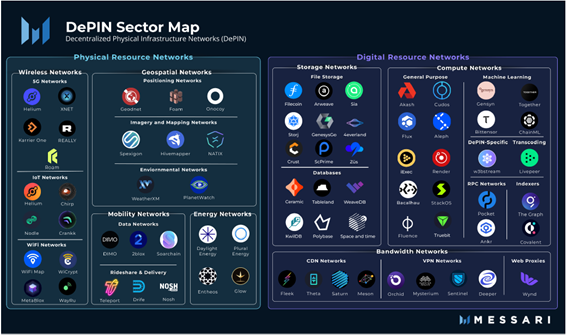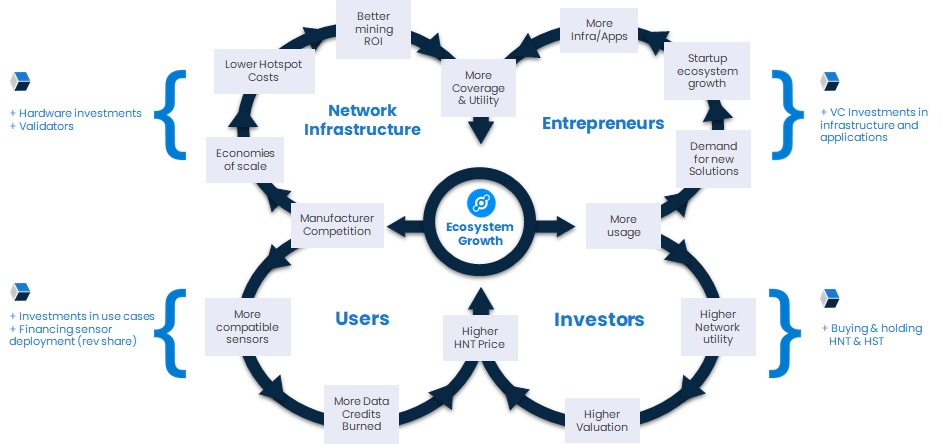Everything started with the creation of the Metaverse Business Unit, but also, in Telefónica Ventures, we have already done some strategic investments (Bit2me, Nova Labs (Helium), Borderless), backing TEF Metaverse Business Unit roadmap.
In this paper we want to tell you about the principles in which is based one of those builders, it is the use of blockchain for decentralize resources through tokenization.
Decentralized Physical Infrastructure Networks – DePIN
DePINs are defined as networks that use tokens to incentivize people to crowdsource and build of real-world physical infrastructure networks.
For a better understanding we’ll continue amplifying it: Networks (decentralized blockchain networks) that use tokens (digital tokens and/or cryptocurrencies) to incentivise people to crowdsource and build (get communities of people to find, fund and set up) real-world physical infrastructure networks (networks of real, connected machines, devices, vehicles or robots which provide goods and services to people and machines in the real world).
This trend may have been also known under other different names, such as EdgeFi, Proof of Physical Work (PoPW), or Token Incentivized Physical Networks (TIPIN). But it seems that the industry now has reach a consensus with DePIN.
The term is unassuming but with it comes the potential to unite Web3s most promising fields, the Internet and the Economy of Things. Be part of a Decentralized Physical Infrastructure Network is associated to receive token rewards, they permit to buy something tangible (like power grid, telecom services, web access…) or be used to govern the network which manages these tangible goodies. It’s, basically, utility and governance tied to real-world products or services, unlike some other stuff in Web3.
In other words, DePINs use blockchain and tokens to create and incentivise the deployment and use of value-generating physical infrastructure. DePINs rely on a decentralized network and community, not a centralized backend and company, for transactions and business logic.
The DePIN Flywheel
Due to their use of a token, DePIN projects can benefit from a positive flywheel effect, where increased usage (demand) increases token price, which then provides extra incentive for contributors to continue building out the network as the dollar value of the tokens they are paid increases.
As the network grows, investors become more and more interested and begin to support the project with funding. If a project is open-source or makes contributor/user data available to the public, developers can build dApps on top of the data, creating additional value within the ecosystem which attracts more users and contributors alike. The image below demonstrates an example of how this Flywheel works in the market today.

Source: Self-production
The DePIN economic flywheel effectively solves the chicken-and-egg dilemma. Through token incentives, DePINs motivate participants to build and expand the supply side to the point where end users find it attractive to use. This enables DePINs to build up the initial momentum needed to gain adoption and compete with Web2 companies.
DePIN vs Status Quo
These are some of the reasons why this new paradigm is going change the actual situation:
- By crowdsourcing physical infrastructure, DePINs can hyper-scale faster than traditional projects, by being distributed among the network participants and offset by future growth and revenues.
- The communities can own the hardware making up the network, the hardware/services they need and use. This aligns the interests of the stakeholders to foster adoption and growth.
- While traditional infrastructure projects often end up with a centralized entity establishing terms and conditions for what you can do and use, DePINs are open, democratic, and accessible.
- Besides being permissionless and open, DePINs are also censorship-resistant, with no centralized gatekeeper capable of denying access for whatever reason.
While a lot of the above is great in general terms, innovation must always be underpinned by a clear-cut business advantage to make it long-term. In this case, DePINs offer a variety of competitive edges over the traditional model:
- By crowdsourcing the hardware and its maintenance, DePINs operate at a fraction of the capital and operating costs of traditional companies, the model incentivizes network members to take care of this while everyone profits.
- By leveraging blockchain, DePINs offer its members secure peer-to-peer payments without having to rely on payments processor intermediary taking a cut.
- As Web3 native, DePINs also grant the network participants direct access to a variety of Web3 tools and DeFi services, such as financing new hardware, that can unlock even more revenue streams for them.
- By reducing the barriers to entry thanks to the distribution of the upfront capital needs, DePINs bring new competition into a variety of industries that have been dormant for a while, incentivizing innovation across the board.
Physical Resource Networks vs Digital Resource Networks
DePINs are divided in two groups, depending on the products and services the network is offering:
- Physical Resource Networks (PRNs) incentivize people to direct or deploy location-dependent hardware to offer real-world, non-fungible goods and services (like geospatial, mobility, energy or connectivity).
- Digital Resource Networks (DRNs) incentivize people to direct or deploy hardware to offer fungible, digital resources (like storage, bandwidth or compute).
State of the art
Through the competitive edge that comes with all the above and their community spirit, they will be able make dent across industries, pushing out the stablished companies as the disruptors they are.
In the image below, produced by Messari, it is possible to discover the ecosystem map.

Source: Messari.io Navigating DePIN Domain
Telecommunication DePINs
For example, let’s take internet access in the developing world: Bringing the infrastructure needed to connect small and remote communities often implies a high upfront cost that most cases are not profitable to companies. DePINs empower communities to take matters into their own hands, covering the upfront costs and labor themselves.
The access-to-internet case is particularly interesting because it’s a duplicator. More people with internet access can lead to more DePIN projects to do with telco, energy, IoT… you name it.
Telefonica is obviously impacted by one of the four principal sub-sectors that already has some networks deployed and working, thus why we are following their progress from inside, incorporating Nova Labs to Telefonica Ventures portfolio, core company of the Helium network.

Source: Borderless, Helium ecosystem
Telefónica Ventures is one of the Telefónica’s Corporate Venture vehicles for strategic investments. We aim to address the big challenges facing Telco industry and create new businesses and verticals aligned with the core strategy from Telefónica, leveraging cutting edge technology. Definitely DePINs are within our investment thesis.










